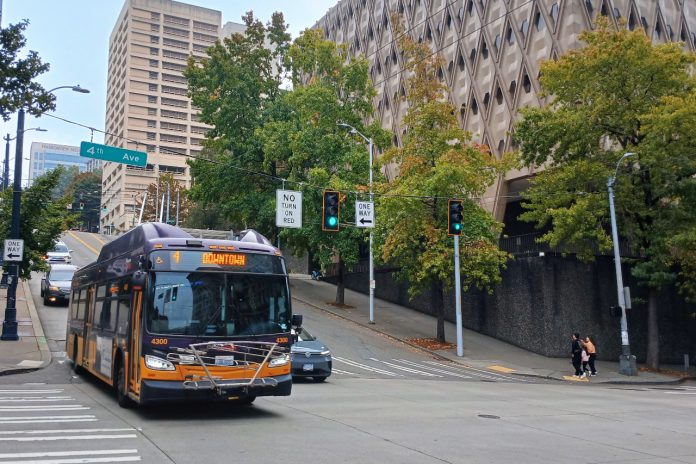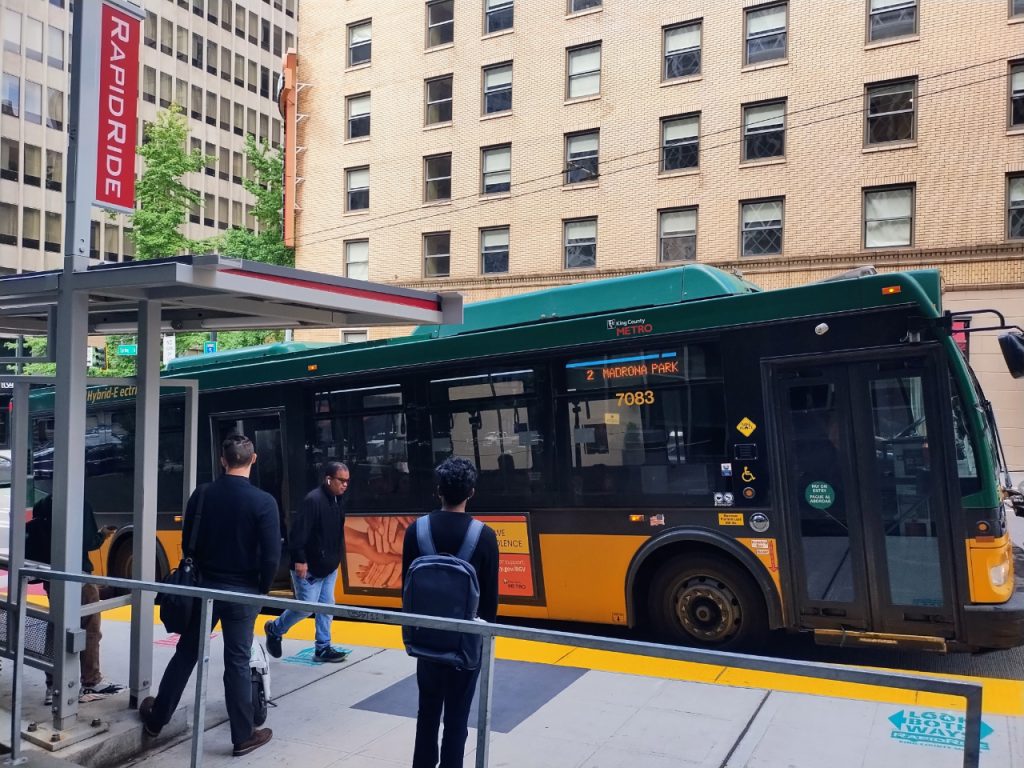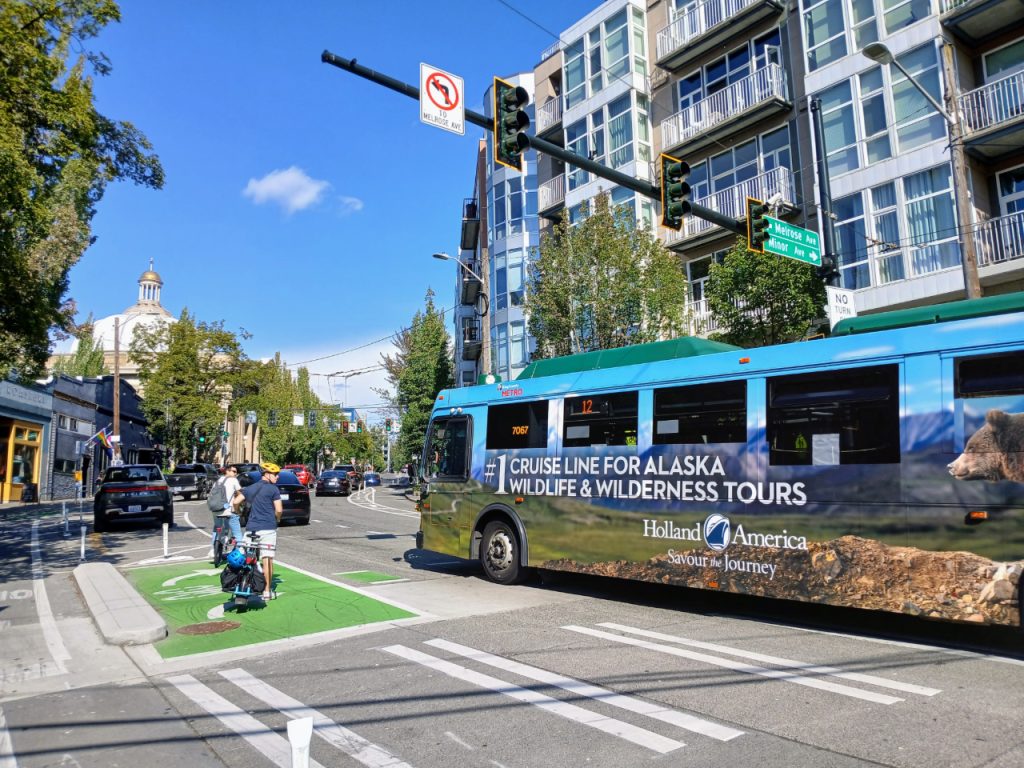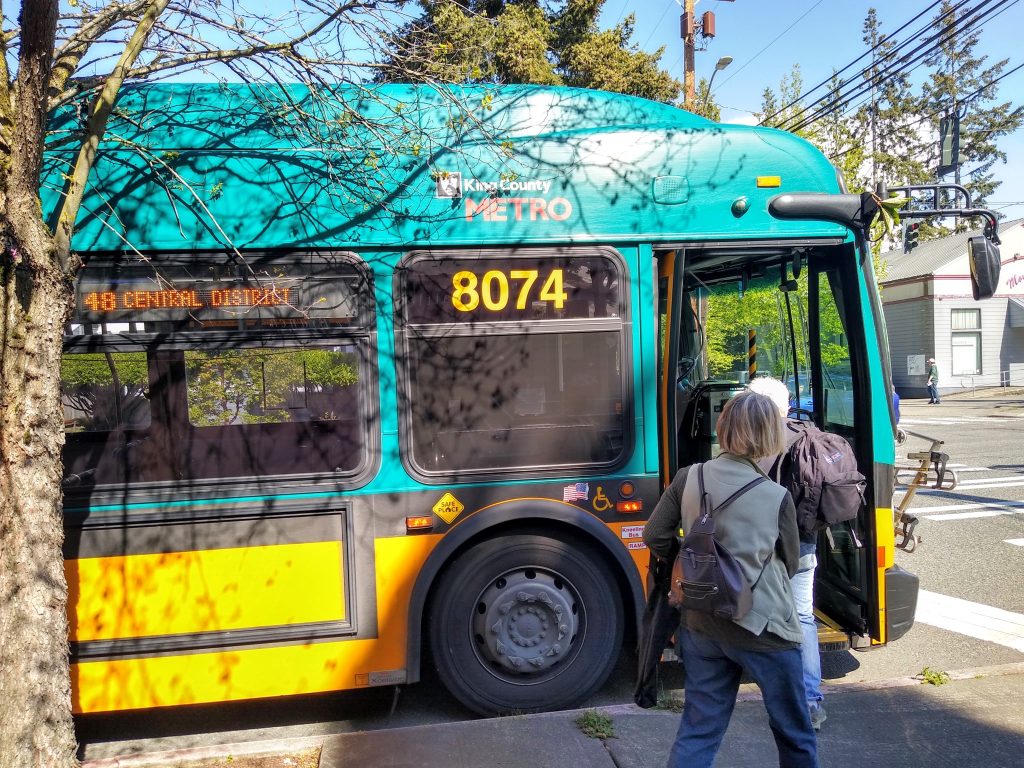
Electric trolleybuses wouldn’t return to Route 12 until 2029 or to Route 48 until 2032.
King County Metro is in the middle of an electrification reset, as county leaders recalibrate on the question of how best to move the agency toward a zero-emission future amid a precarious funding landscape. As part of that reset, Metro is set to give some attention to an old standby: electric trolleybuses. But while the agency’s proposed biennial budget includes a funding boost to advance a slate of trolley projects, those plans are coming with timelines that are likely to give Seattle transit advocates heartburn.
Metro’s electric trolley network is the second largest in the U.S. and a quiet workhorse of the bus system. Seattle’s trolley network has been operating continuously for 85 years. The 14 trolley lines include some of the busiest routes in the city like the Route 7 and 49, though only 12 of those 14 routes are currently operating. In recent years, as Metro has grappled with an ambitious goal handed down from the King County Council to fully electrify its fleet by 2035, trolleybuses have taken a backseat to battery-electric buses that are expected to be more versatile.
With Metro now proposing a more incremental approach to electrification, Interim County Executive Shannon Braddock’s proposed biennial budget includes a big boost in trolleybus funding and advances a number of programs that would restore parts of the trolley network — and potentially set up future expansion. But for such a tried-and-true method of electrification, riders are set to be waiting a long time to see their routes gliding under wires, a fact that Metro blames on materials availability, permitting, and staff.
While a major benefit from converting diesel-hybrid bus routes to trolleys is decreased carbon emissions and exhaust, there are additional benefits as well. People living along trolley routes undoubtedly appreciate their relative quiet, and trolley coaches are generally able to handle hills better than their diesel equivalents.
Restoring trolley service to the 2 and 12
The RapidRide G Line has been open and serving riders in First Hill, Capitol Hill, the Central District, and Madison Valley with frequent service for over a year now. But the two trolley routes that had intersected the G Line are still operating with diesel buses, a fact that stems from required adjustments to trolley-wire infrastructure that occurred during G Line construction.
In the case of the Route 2, which runs between Madrona and Queen Anne via First Hilll and Downtown Seattle, building the G Line required removing a major stretch of trolley wire around 12th Avenue and E Madison Street. The full rebuild Madison Street underwent as part of the $144 million transit project required significant utility relocation and readjustment, and now the 2 has a major gap in trolley wire that needs to be filled in. While this is the first major trolley restoration Metro expects to complete, it won’t be ready for another year.

“Several critical poles used to support the overhead contact system (OCS) for Route 2 were damaged during construction of the RapidRide G Line,” Metro spokesperson Al Sanders told The Urbanist. “These poles must be replaced before the OCS can be fully reinstalled, which has delayed the work. The schedule for completing the work by Fall 2026 takes into account the time required for permitting, purchasing poles and other parts, and construction. Supply chain issues related to parts purchasing have also contributed to delays on the project.”
Route 2 is also set to finally take advantage of the westbound bus-only lane onto E Union Street at Madison built for it during G Line construction, after forthcoming changes completed by the City of Seattle adding a pedestrian signal to the intersection. Initially, the Seattle Department of Transportation (SDOT) wanted to reopen that bus lane to general purpose traffic at the same time that those changes were made, but quick advocacy by transit riders won a retreat on that idea. While there is no concrete timeline to opening that bus lane, it should happen much sooner than returning trolleys to the route.
What about the Route 12, a trolley route that used to cover much of the RapidRide G’s current route along Madison but now runs along E Pine Street? Metro says trolleys won’t return to that line until 2029, with a short gap in infrastructure between 15th Avenue and E Madison Street the main culprit.

“Restoration of trolleybus service on Route 12 is currently expected in 2029 due to the planned timeline for constructing new trolley infrastructure on the segment of E Pine St between 15th Ave and E Madison St,” Sanders said. “Metro is currently assessing whether off-wire operations on this segment would be possible using the new higher-capacity batteries that are being installed on the Metro trolleybus fleet, which may allow Route 12 to return to trolleybus service sooner.
The Urbanist reported last year on Metro’s plans to upgrade the batteries across the trolleybus fleet, a move that would allow coaches to travel over seven miles after being disconnected from the overhead wires. While there’s a possibility that technology could significantly expand the number of routes where trolleys make sense, so far there are no signs that Metro has gotten to that point yet.
Electrifying the 48… by 2032
For well over a decade, Metro and the City of Seattle have been working to electrify the Route 48, which runs between Mount Baker and University District. Most of the route already runs underneath wires, with only a few short stretches missing coverage. However, despite a major overhaul of 23rd Avenue completed by the Seattle Department of Transportation (SDOT) that added poles for trolley wires along those missing sections, the route remains a long way from being able to operate with trolleys.
Metro now says that it doesn’t expect to be able to finish work electrifying the 48 until 2032, a full 18 years after SDOT completed its 2014 electrification study.

While the Seattle Transit Blog had reported several years ago that it looked like a 2026 date for electrifying the 48 was within reach, since then Metro has once again put it on the back burner due to limited resources.
“A significant factor in the delays to date on the Route 48 project has been Metro’s extensive Capital Improvement Program and limited staff resources to deliver it” Sanders said. “Metro has many competing priorities across our capital programs, and we have had to prioritize some projects over others. This project was delayed during the preliminary design phase due to the need to focus resources on other projects”
Metro now plans to spend $2.7 million on Route 48 electrification over the next two years, and finally advance work again.
“During this delay, Metro has been adding staff capacity and will be able to devote resources to continuing design work on this project,” Sanders continued. “When it resumes, significant work remains related to refining analysis to determine whether one or two traction power substations are needed, designing and siting the substation(s), and overhead contact system design. This design work and expected construction durations were factored into developing the schedule to complete the project.”
Braddock’s budget also includes nearly $900,000 for trolley network planning, spending that could identify future trolley projects down the line. Just how down the line remains to be seen. What is also not fully clear is the degree to which any of this work work could be expedited with additional partnership with the City of Seattle, which should also be taking advantage of any opportunity to electrify Metro routes.
While additional attention to the trolley network is welcome news for transit fans, the long timelines spelled out here are likely to leave a bitter aftertaste.
Ryan Packer has been writing for The Urbanist since 2015, and currently reports full-time as Contributing Editor. Their beats are transportation, land use, public space, traffic safety, and obscure community meetings. Packer has also reported for other regional outlets including BikePortland, Seattle Met, and PubliCola. They live in the Capitol Hill neighborhood of Seattle.

